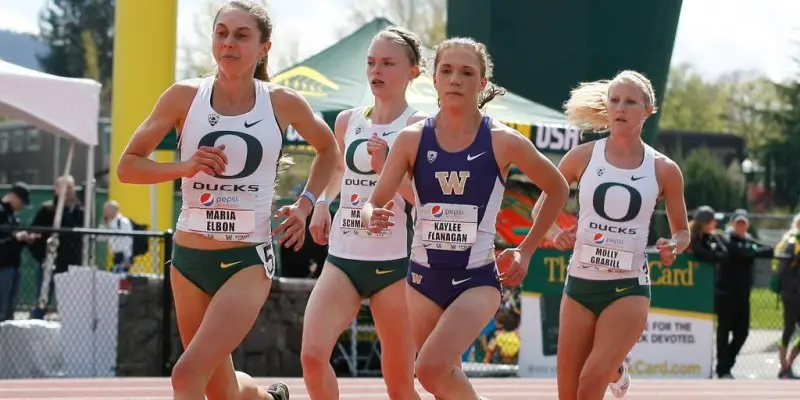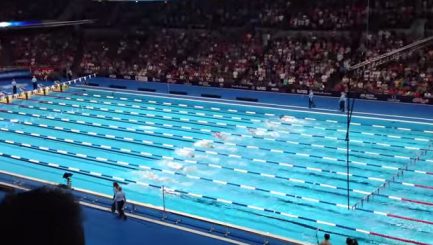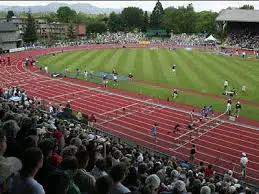Mike Merrell’s Three-and-Out
With the upcoming NCAA Track & Field Championships – and with the utter failure of the preliminary rounds as spectator events — those who oversee the events ponder what to do to generate more spectator interest, and, presumably, therefore more dollars. But maybe efforts to promote track & field should be made with something besides dollars in mind.
Over the past few years I’ve had the good fortune to attend a variety of high-profile athletic events, including the NCAA Track & Field Championships, the Rose Bowl and the 2012 U.S. Olympic Swimming Trials. Possible models for promoting track & field is the subject of this week’s Three-and-Out.
1. Football. Very unlike track & field, football is head-to-head symbolic warfare. Football is primal. It’s us vs them, good vs evil, love vs hate, live vs die — at least emotionally.
There is no consolation in coming in second. It’s win or lose. And for fans, how your team plays the game is a distant afterthought. Any win — no matter how bad — would stand head and shoulders over the best loss, if only there were such a thing. But there isn’t. There’s no silver medal. No bronze. It’s gold or nothing.
Good sportsmanship is defined as stopping short of spitting on the opposition or its fans, and “good-natured” ribbing to oppositional friends still deliberately delivers pain.
Any cheers for players on “the other team” are reserved for when they are merely maimed and helped off the field by teammates or on a cart, rather than leaving in a hearse. Good play by the opposition is greeted by under-the-breath cuss words at best.
For us fans, it is emotional gambling, living vicariously on the achievements of our favored teams. And in the end, either we win, or they lose.
There is little that track & field could do to capture the appeal of football. It simply is not about us vs them. On rare occasions it may be possible to vilify an individual here or there, but it really isn’t part of the sport — nor should it be.
Besides that, where could you put the cheerleaders where they wouldn’t get in the way or end up being javelin catchers? There’s just not much in the success of football that translates to track & field. It’s a different thing entirely.
2. Swimming. Swimming, on the other hand, faces many of the same challenges as track & field. It’s only primal when someone’s faced with drowning. But it’s amazing how infrequently that happens with athletes who swim up to six or more miles per day and have been doing it since they were eight years old. So, forget the life-or-death element.
The 2012 U.S. Olympic Swim Trials were held in Omaha at the same venue where the Oregon basketball team played in the 2015 NCAA Basketball Tournament. Interestingly, you may have noticed that there was no swimming pool there by the time the Ducks showed up for basketball. The pool was actually delivered in pieces and assembled in under two weeks. After the meet, it was moved to London, where it hosted the 2012 Olympics. The very same pool.
That’s a swimming pool over half the length of a football field, half as wide and a minimum of six and a half feet deep packed up and moved out — along with a warm-up pool the same size. Here’s how they did it:
Unfortunately, most track competitions struggle to fill venues with lower seating capacities, so to the extent that temporary quarters could be established in larger venues, it would only result in more empty seats.
But for one major event, the temporary competition venue worked for USA Swimming. By bringing the pool to the venue, there was instant seating for about 15,000 spectators — something the average swimming pool does not have. And many of the semi-finals and finals were televised live on NBC.
To spice up the event, spectators — and presumably the live television audience when not subjected to “TV timeouts” — were treated to flame throwers along the side of the pool, an extravaganza light show, ear-splitting rock & roll and an announcer on steroids. He did his best to keep us engaged during the ten-minute television timeouts, since we didn’t have the privilege of being reminded that to ditch our glasses, grow a competitive five o-clock shadow and have our wives become hotter like Garcia’s across the street, all we would have to do is buy a Buick.
It may have looked good to those on the couches in front of their televisions, but for lovers of the sport, the frills were an intrusion between fans and athletes. Adding distractions as a side show (not to mention the television timeouts) — in my opinion, at least — only diminished the glory of the event. And the same would hold true for track & field.
3. Track & Field. Track & field, like swimming, is not primal, so it can never appeal to our urge to gloat in victory while we watch our opponents wallow in the sorrow of defeat. Track & field fans actually cheer for the opposition. At least they do at Historic Hayward Field, and that’s as good as it gets.
There’s nothing primal about that — but there’s something better. As fans connect with athletes from teams other than their own, they also connect with their more highly evolved inner fan beings. It’s not about us vs them. It’s about appreciation of fellow human beings and what we can accomplish with dedication — regardless of the color of our shirts.
Rather than inspiring us to down a few brews in celebration or sorrow, these athletes — runners, jumpers, throwers and swimmers — inspire us to get off the couch and lace up the Nikes, or go to the pool and grind out some laps. Light shows, flame throwers, announcers on steroids and Buick ads only get in the way of this special bond that forms between these “non-revenue” athletes and their fans.
The future for generating more interest does not involve changing the essence of the sports, dumbing them down with fireworks, or in separating men’s and women’s competitions in order to make things easier to follow. The sports are fine as they are.
It’s the mindset of potential fans that needs the change — and that’s where marketing efforts should be directed.
And if the mindset changes enough, chances are the rate of obesity in the country will start dropping and the tobacco companies will go out of business. At some point, we need to wake up and realize that not every success should be measured in dollars.
Top photo by Gary Breedlove
Related Articles:
Mike (Editor-in-Chief) is a 1970 graduate of the University of Oregon where he attended the Honors College and received all-conference honors as a swimmer. After college, Mike ran for the Oregon Track Club and narrowly missed qualifying for the US Olympic Trials in the marathon. He continues his involvement in sports with near-daily swimming or running workouts, occasional masters swim competition (where he has received two Top-10 World rankings), providing volunteer coaching to local triathletes and helping out with FishDuck.com.
Mike lives on 28 acres in the forest near Sandpoint, Idaho, where he has served as a certified public accountant for most of his working career. His current night job is writing novels about Abby Westminster, the only known illegitimate daughter of Britain’s finest secret agent who has to bring down arch-villains plotting dastardly deeds. And, yes, Abby is also a DUCK!




